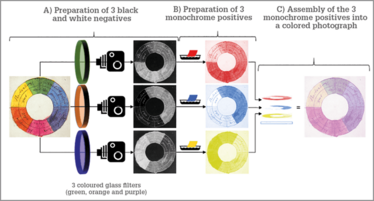Photos in Focus
Using synchrotron spectroscopy to work out the chemistry behind 200-year-old photographs – and raise the profile of a long-neglected artist
Marine Cotte works in the European Synchrotron Radiation Facility, Grenoble, France, where her job is to support researchers in their scientific endeavours. A colleague asked for Cotte’s help to analyze some fragments of a photograph produced by pioneer of color photography, Louis Ducos du Hauron.
“I first used infrared microscopy, which allows you to scan two-dimensional regions, define the pixel size and then move from one pixel to another, acquiring an infrared spectrum at each pixel. In this way you can ascertain the molecular composition, as well as see where the molecules are distributed,” Cotte says. “Synchrotron infrared microscopy turned out to be very efficient for the identification of organic components, such as gelatine, celluloid, resin, oil, and so on.”

Pioneering photographer Ducos du Hauron developed the general principle of three-color carbon printing (1).
Cotte also used X-ray microscopy to work out the elements of composition, and in particular, to identify the pigments. “Ducos du Hauron’s books showed he didn’t use the same pigment at the beginning of his career as he did later on,” she explains. “By identifying the pigments, we could work out a kind of ‘chronological marker’; for example, we could identify Prussian Blue pigment by the presence of iron.” The next step was to identify the technique used for printing, and for this they used X-ray fluorescence spectroscopy to distinguish different oxidation states. The presence of chromium suggested carbon printing.
Despite his contribution to the photography field, Ducos du Hauron never enjoyed commercial success. “I had not heard of him – barely anyone had – until recently, but his work has become important to me,” says Cotte. “He was really passionate, spending 40 years constantly trying to improve, not to make a profit, but simply to develop a technique that anyone could use.” Some museums are exploring the idea of exhibitions to coincide with the anniversary of his death, which, Cotte hopes, will give Ducos du Hauron some visibility. “Hopefully the museums – and our scientific research – will finally give him some of the recognition he deserves,” she says.
- M Cotte et al., “Rediscovering Ducos du Hauron’s color photography through a review of his three-colour printing processes and synchrotron microanalysis of his prints”, Angew Chem Int Ed, 57, 1-6 (2018). DOI: 10.1002/anie.201712617.
A former library manager and storyteller, I have wanted to write for magazines since I was six years old, when I used to make my own out of foolscap paper and sellotape and distribute them to my family. Since getting my MSc in Publishing, I’ve worked as a freelance writer and content creator for both digital and print, writing on subjects such as fashion, food, tourism, photography – and the history of Roman toilets. Now I can be found working on The Analytical Scientist, finding the ‘human angle’ to cutting-edge science stories.

















